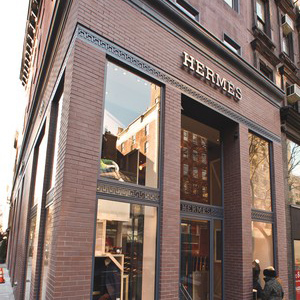“God Bless America” could be a new anthem for Europe’s big luxury goods players, beset by the slowdown in China as well as persistent economic volatility in Europe.
In disclosing a 13.9 percent leap in first-half profits at Hermès International, co-chief executive officer Axel Dumas marveled that the U.S. represents an established market for the company, yet one whose growth axis resembles an emerging country.
“There is something very buoyant and very vibrant in the U.S.,” Dumas told wwd on Friday on the sidelines of Hermès’ results presentation, where he trumpeted a 16.5 percent revenue bump in the Americas, only slightly behind the Asia-Pacific region, at 16.9 percent.
“We are just at the beginning of what could be a good trend,” he continued, adding that Hermès’ business in the U.S. has accelerated, particularly in the past five to eight years.
Dumas noted Hermès would not increase the number of U.S. stores, and would focus more on increasing the size of key units, such as the Beverly Hills flagship, which is slated to open today with 12,000 square feet of selling space and a striking marble facade.
Next year, Hermès is slated to open a flagship unit in Miami’s Design District and a location at the Buckhead Atlanta, as reported. It also signed a lease to open in Brookfield Place, formerly known as the World Financial Center, due to open in 2014.
Luca Solca, luxury goods analyst at Exane BNP Paribas, said he found Dumas’ comparison controversial and noted that luxury expenditure per capita in Asia remains higher than in America, and when it is expressed as a ratio to GDP, Europe and the U.S. “look very similar,” whereas “Asian markets are off the chart.”
At constant exchange rates, first-half sales at Hermès grew 13 percent in France, 14.3 percent in the rest of Europe, 8 percent in Japan and 22.3 percent in other countries.
Meanwhile, Dumas, who is to succeed co-ceo Patrick Thomas later this year or early next, promised “continuity” with the management’s “prudent” approach to business; and its prickly relations with luxury rival LVMH Moët Hennessy Louis Vuitton, its second-largest shareholder after members of the controlling Dumas, Puech and Guerrand families.
He scoffed when asked if Hermès might consider cooperating with LVMH, which in July revealed it had raised its stake in the maker of Birkin bags and silk scarves to 23.1 percent as of June 30, from 22.6 percent as of Dec. 30, 2012.
Asked about revenue trends in July and August, Dumas said they were broadly in line with the first half. The company reiterated its guidance for 2013 margins, expected to approach the all-time high reached in 2012, and its sales forecast, with the figure expected to “slightly” exceed the mid-term growth target of 10 percent.
Net profits in the half totaled 381.7 million euros, or $501.2 million. Operating profits in the six months to June 30 improved 14.3 percent to total 584.1 million euros, or $767 million.
The company credited a positive impact from its currency hedging for a one-point improvement in its operating margin, which reached 33.1 percent of sales.
Hermès reported revenues last month. In the second quarter, they rose 11.8 percent to 910.4 million euros, or $1.18 billion. In the half, sales gained 11 percent to 1.77 billion euros, or $2.32 billion. Stripping out the impact of currency, the increase stood at 14.4 percent.
Dollar figures are converted at average exchange rates for the periods in question. By product category, ready-to-wear and fashion accessories gained 21 percent; perfumes 20 percent; silk and textiles 13 percent, and leather and saddlery 10 percent. Watches slipped 1 percent, reflecting the downturn in the sector and tough comps, Hermès said. Sales of other products; including jewelry and home wares; increased 40 percent.
source: wwd






